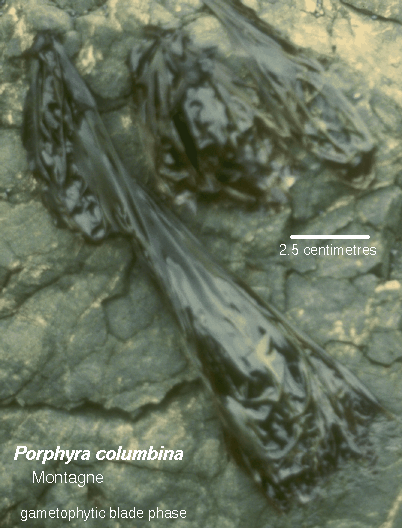
Porphyra thalli appear in nature as free-living, easily visible thin blades (the phase that is harvested for nori) and as tiny, microscopic filaments that bore into calcium carbonate substrate.
 | Porphyra blades may be anywhere from circular to linear in outline, and from a few centimetres to over a metre in length. The color is also variable, from rose-pink in species that live entirely submerged, to variously mottled reds, yellows, browns and greens in intertidal species. The actual size and color of any given specimen depends on the species, the position of the specimen in the intertidal or subtidal zones, the season, the prevailing weather, and other factors. Hence, blade size and color are poor taxonomic indicators. |
The blades consist of one or two rigorously coplanar layers of cells. The cells are more or less evenly distributed within the layer and are encased in a stiff mucilage. The cells are uninucleate and contain one or two stellate plastids with a conspicuous pyrenoid in the exact center of the plastid - the uninitiated often confuse the pyrenoid with the nucleus. There are no cytoplasmic connections ("pit connections") between cells; this feature separates Porphyra and its close relatives from other red algae. Cells at the base of the blade produce rhizoids, which affix the blade to the substrate. Cells at the margin of the blade in mature plants cleave sequentially to produce male gametes, or "carpospores" (the products of gamete fusion; see Life history), or both.
 | Microscopic Porphyra consists of branched filaments with cells 2-10 micrometres in diameter and usually many times longer than broad. Pit connections are present between cells. The plastid(s) line the cell's wall and are not stellate. Pyrenoids are inconspicuous in or absent from the plastids. These filaments are so unlike the blades in their structural features that, when first discovered, they were placed in a different class, order and genus (Conchocelis) of red algae - hence the names "conchocelis filaments" and "conchocelis stage". Conchocelis filaments in nature are always found boring into a calcium carbonate substrate. For example, the conchocelis of many intertidal species resides in the shells of living intertidal barnacles. |
Return to summary information